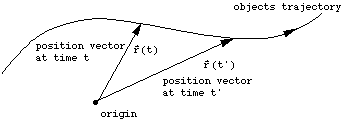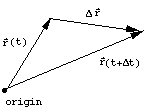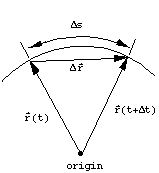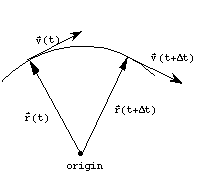We now leave probability for the moment, and start our discussion of the basics laws of physics: Newton's Laws of Motion.
1) An object at rest stays at rest, and an object in a state of motion in a straight line with constant speed stays so moving, unless the object is acted upon by external forces. (Law of Inertia)
2) When an external force acts on an object, the
acceleration,
which is the rate of change of velocity with time, is proportional to the
external force. The constant of proportionality is called the inertial
mass of the object. In mathematical notation, ![]() (the arrows over the symbols indicate that they are vectors - we will explain
what a vector is shortly).
(the arrows over the symbols indicate that they are vectors - we will explain
what a vector is shortly).
3) Forces come in equal and opposite pairs -"for every action there is an equal and opposite reaction". If particle A exerts a force on particle B, then particle B exerts a force equal in magnitude but opposite in direction, on particle A.
In order to use Newton's Laws of motion to describe how objects move when acted on by forces, we need first a mathematical concept to describe the position of objects, and their motion. This is the vector. A vector is something that specifies both a magnitude and a direction. The simplest example of a vector is the position vector.
The position vector locates the position of an object
with respect to some fixed point in space, which we call the "origin".
We can graphically represent the position vector as an arrow pointing from
the origin to the location of the object. The magnitude of the position
vector is just the length of the arrow, or equivalently the distance between
the origin and the object. We denote the position vector by the symbol ![]() (with an arrow above), and the magnitude of the position vector by the
symbol
(with an arrow above), and the magnitude of the position vector by the
symbol ![]() (without
the arrow above).
(without
the arrow above).

For an object which is moving along a trajectory
in space, we can describe the position vector of the object as it varies
in time by the symbol ![]() ,
which is read as "
,
which is read as "![]() as a function of t", and means that the object is at position
as a function of t", and means that the object is at position ![]() at time t.
at time t.

Addition of vectors
Suppose one is at position ![]() at time t, and at position
at time t, and at position ![]() a small time
a small time ![]() later (in physics notation,
later (in physics notation, ![]() usually means a small increment in something; here
usually means a small increment in something; here ![]() is
a small increment in time). If we draw the arrow starting from the tip
of
is
a small increment in time). If we draw the arrow starting from the tip
of ![]() and
ending at the tip of
and
ending at the tip of ![]() ,
we call this the difference vector
,
we call this the difference vector ![]() .
.

If we think of the position vector as the straight
line path we must walk along to arrive at the point ![]() when starting from the origin, then
when starting from the origin, then ![]() gives the straight line path we must walk along to arrive at the point
gives the straight line path we must walk along to arrive at the point ![]() when starting from the point
when starting from the point ![]() .
We can thus write
.
We can thus write
![]()
and interpret this addition of vectors geometrically
as follows: to go from the origin to the point ![]() we can either go in a straight line directly to
we can either go in a straight line directly to ![]() ,
or else we can go first to the point
,
or else we can go first to the point ![]() and then walk along the straight line path given by
and then walk along the straight line path given by ![]() .
Both these two routes wind up at the same end point
.
Both these two routes wind up at the same end point ![]() .
.
We can add many vectors up the same way. Just place the arrows end to end, one after the other to get:

![]()
Walking along the path specified by the vectors ![]() ,
, ![]() ,
, ![]() ,
and
,
and ![]() is
equivalent to taking the straight path along
is
equivalent to taking the straight path along ![]() .
.
Using this definition of addition of vectors, we can also define the difference between two vectors:
![]()
Note that when we write the vector equation ![]() it does not mean that the total distance traveled in walking along
the path described by
it does not mean that the total distance traveled in walking along
the path described by ![]() is the same as the total distance traveled in walking along the straight
path described by the vector
is the same as the total distance traveled in walking along the straight
path described by the vector ![]() .
This is obvious from the figure above. In terms of the magnitudes
of these vectors,
.
This is obvious from the figure above. In terms of the magnitudes
of these vectors, ![]() .
It is only in terms of the full vector quantities, which include the direction,
that the vector equation gives an equality.
.
It is only in terms of the full vector quantities, which include the direction,
that the vector equation gives an equality.
Circular Motion - velocity and acceleration vectors
Consider an object traveling clockwise in a circular
orbit of radius r, going around the circle with a constant rate of rotation
(such as does a hand of a clock). The distance the object travels in going
one complete turn around the orbit is the circumference ![]() .
The time it takes to do so is called the period of the orbit, and we denote
it by the symbol
.
The time it takes to do so is called the period of the orbit, and we denote
it by the symbol ![]() .
The average speed v of the object is then
.
The average speed v of the object is then
speed = distance/time, ![]()
We now define the velocity vector. Consider
how the position vector changes as the particle moves from time t to time ![]() .
We take as the origin the center of the circle.
.
We take as the origin the center of the circle.

The average velocity ![]() between times t and
between times t and ![]() is defined as the time rate of change of the position vector:
is defined as the time rate of change of the position vector:
![]()
The instantaneous velocity vector at time t is then
given by the above, as we take the time difference ![]() .
.
To compute ![]() ,
note that as
,
note that as ![]() the displacement vector
the displacement vector ![]() gets smaller and becomes equal in magnitude to the arc length
gets smaller and becomes equal in magnitude to the arc length ![]() .
Since the object is going around the circle at a constant rate, the ratio
of the length
.
Since the object is going around the circle at a constant rate, the ratio
of the length ![]() to the entire circumference
to the entire circumference ![]() is equal to the ratio of
is equal to the ratio of ![]() to the period of the orbit
to the period of the orbit ![]() .
So
.
So
![]()
The magnitude of the velocity vector is then
![]()
Thus the magnitude of the instantaneous velocity vector, called the instantaneous speed, is just equal to the average speed around the circle. This is reasonable since we said that the object is going around the circle at a constant rate.
The direction of the instantaneous velocity vector
is obtained by looking at the above diagram as ![]() the two radial position vectors get closer and closer, and the direction
of
the two radial position vectors get closer and closer, and the direction
of ![]() becomes
tangent to the circle. Since the direction of
becomes
tangent to the circle. Since the direction of ![]() is determined by the direction of
is determined by the direction of ![]() ,
we conclude that the velocity vector
,
we conclude that the velocity vector ![]() always points tangent to the circle, perpendicular to the position vector
always points tangent to the circle, perpendicular to the position vector ![]() .
(Henceforth we will always mean the instantaneous velocity whenever we
say simply "velocity", unless we explicitly indicate otherwise.)
.
(Henceforth we will always mean the instantaneous velocity whenever we
say simply "velocity", unless we explicitly indicate otherwise.)


In general, the velocity is a vector whose magnitude is equal to the instantaneous speed, and whose direction points tangent to the direction of motion.
We now define the acceleration vector ![]() .
The acceleration vector is the time rate of change of the velocity vector:
.
The acceleration vector is the time rate of change of the velocity vector:
![]()
where one is to take the limit as ![]() .
We define geometrically the velocity difference vector
.
We define geometrically the velocity difference vector ![]() as shown above, in analogy to how we defined the position difference vector.
To compute the magnitude of
as shown above, in analogy to how we defined the position difference vector.
To compute the magnitude of ![]() as
as ![]() , we
use an argument similar to the one we used to compute the magnitude of
, we
use an argument similar to the one we used to compute the magnitude of ![]() .
Since
.
Since ![]() has a constant magnitude independent of time, we can draw the vectors
has a constant magnitude independent of time, we can draw the vectors ![]() as radii of a circle of constant radius v.
as radii of a circle of constant radius v.

As ![]() ,
the length of
,
the length of ![]() become equal to the arc length of the circle between the points
become equal to the arc length of the circle between the points ![]() and
and ![]() . Now
since
. Now
since ![]() is always perpendicular to
is always perpendicular to ![]() ,
the angle swept out on the above circle as
,
the angle swept out on the above circle as ![]() rotates into
rotates into ![]() ,
is the same as the angle swept out as
,
is the same as the angle swept out as ![]() rotates into
rotates into ![]() .
Since the rate of rotation is constant, this angle is in the same ratio
to the total angle
.
Since the rate of rotation is constant, this angle is in the same ratio
to the total angle ![]() as the time difference
as the time difference ![]() is to the total period of the orbit
is to the total period of the orbit ![]() .
Therefore the arc length
.
Therefore the arc length ![]() is in the same ratio to the total circumference of the above circle
is in the same ratio to the total circumference of the above circle ![]() ,
as
,
as ![]() is
to
is
to ![]() . We thus
have
. We thus
have
![]()
so the magnitude of the acceleration vector is
![]()
Using our earlier result that ![]() ,
we can rewrite the above by either substituting for v in terms of r and
,
we can rewrite the above by either substituting for v in terms of r and ![]() ,
or by substituting for
,
or by substituting for ![]() in terms of v and r,
in terms of v and r, ![]() .
We then get the equivalent expressions
.
We then get the equivalent expressions
![]()
The direction of the acceleration vector is obtained
by noticing that as ![]() ,
the direction of
,
the direction of ![]() becomes perpendicular to the vector
becomes perpendicular to the vector ![]() .
Now since we already found that
.
Now since we already found that ![]() is perpendicular to the position vector
is perpendicular to the position vector ![]() ,
we conclude that the direction of
,
we conclude that the direction of ![]() ,
and hence the direction of
,
and hence the direction of ![]() points opposite to the direction of
points opposite to the direction of ![]() ,
that is
,
that is ![]() points inwards to the center of the circle.
points inwards to the center of the circle.
We therefore see that an object going around in a
circle at constant speed, is experiencing an acceleration which is constant
in magnitude, but whose direction is constantly changing so that it always
points to the center of the orbit. This is known as the centripetal
acceleration of an orbiting object. Since the object is experiencing an
acceleration, Newton's second law, ![]() ,
tells us that the object can only move in such an orbit if there is a force
acting on the object that is constant in magnitude and pointing towards
the center of the orbit (since acceleration is a vector, so must be force).
For a planet orbiting the sun, this force is the gravitational force from
the sun. For a ball being swung around on the end of a string, this force
is the line tension of the string. If at any point the force is turned
off (for example the string is cut), the ball will cease its circular motion
and fly off in a straight line path tangent to the circle.
,
tells us that the object can only move in such an orbit if there is a force
acting on the object that is constant in magnitude and pointing towards
the center of the orbit (since acceleration is a vector, so must be force).
For a planet orbiting the sun, this force is the gravitational force from
the sun. For a ball being swung around on the end of a string, this force
is the line tension of the string. If at any point the force is turned
off (for example the string is cut), the ball will cease its circular motion
and fly off in a straight line path tangent to the circle.
Note: it is a common misconception among begining
physics students that if an object is moving along a certain trajectory,
then there must be a force which is pushing that object along on this trajectory,
and that the force is therefore pointing in the same direction as that
in which the object is moving. Our example of an object in circular motion
shows this notion to be in general false: in the case of circular motion,
the acceleration ![]() points perpendicular to the objects direction of motion!
points perpendicular to the objects direction of motion!
To summarize: an object moving around in a
circle of radius r, at a constant rate of rotation with the period of orbit ![]() ,
has:
,
has:
velocity vector ![]() whose magnitude is the constant speed
whose magnitude is the constant speed
![]()
and whose direction is always tangent to the circle in the direction of motion; and
acceleration vector ![]() whose magnitude is the constant
whose magnitude is the constant
![]()
(where the second equality comes from substituting in for v from above)
and whose direction is always pointing to the center of the circle.
A Word About Units of Measure
Since we are discussing position, time, mass, velocity, acceleration, and force, it is necessary to use a system of units in which we can record measurements. The universally used system in physics is the metric system in which
length is measured in meters, abbreviated by m
time is measured in seconds, abbreviated by s
mass is measured in kilograms, abbreviated by kg
with these basic units,
velocity = length/time is measured in m/s
acceleration = velocity/time is measured in m/s2
force = (mass)(acceleration) is measured in kg m/s2 = nt
The unit of force, kg m/s2, is given the special name, the "newton", and is abbreviated by the letters "nt" or sometimes by "N".
The above is also referred to as the "MKS" system of measurement.